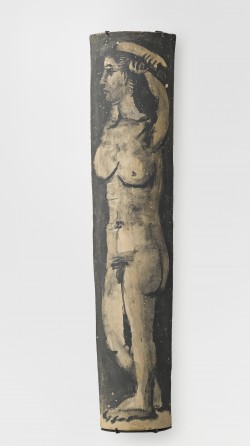
Picasso’s simplified approach to ceramics led him to make use of discarded materials, particularly those connected with the firing process in pottery making. Gazelles, long tiles used to separate the different levels of pottery ovens, often feature in his work, their length and convex shape making them the ideal canvas on which to represent the human form. In this piece, the tile’s elongated shape complements the naked figure, and the artist’s use of contrast and rhythm mirrors the curved surface. The figure has been painted in monochrome using a black engobe or slip (coloured liquid made from clay). The patina created by repeatedly baking the gazelle, the very matt finish and the intentional primitivism of the figure are all elements which lend the finished piece an antique quality, allowing it to blend seamlessly into the history of ceramic art.
Picasso Pablo (dit), Ruiz Picasso Pablo (1881-1973)
Gazelle de four décorée d'une femme nue se coiffant (Gazelle Decorated with a Naked Woman Combing Her Hair)
Vallauris, 19 September 1950
Pink grog, with black engobe decoration
Musée national Picasso-Paris
Donated by the Picasso estate, 1979. MP 3701
© Succession Picasso 2017
Localisation : Paris, musée Picasso
Photo © RMN-Grand Palais (musée Picasso de Paris) / Mathieu Rabeau
